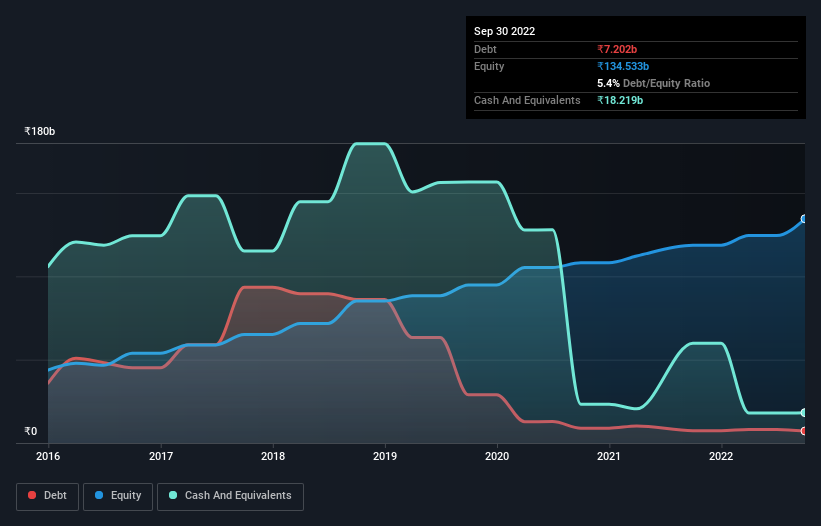Here's Why Rajesh Exports (NSE:RAJESHEXPO) Can Manage Its Debt Responsibly
David Iben put it well when he said, 'Volatility is not a risk we care about. What we care about is avoiding the permanent loss of capital.' So it might be obvious that you need to consider debt, when you think about how risky any given stock is, because too much debt can sink a company. Importantly, Rajesh Exports Limited (NSE:RAJESHEXPO) does carry debt. But is this debt a concern to shareholders?
When Is Debt Dangerous?
Debt and other liabilities become risky for a business when it cannot easily fulfill those obligations, either with free cash flow or by raising capital at an attractive price. Ultimately, if the company can't fulfill its legal obligations to repay debt, shareholders could walk away with nothing. While that is not too common, we often do see indebted companies permanently diluting shareholders because lenders force them to raise capital at a distressed price. Of course, plenty of companies use debt to fund growth, without any negative consequences. The first step when considering a company's debt levels is to consider its cash and debt together.
Check out the opportunities and risks within the IN Luxury industry.
What Is Rajesh Exports's Net Debt?
The chart below, which you can click on for greater detail, shows that Rajesh Exports had ₹7.20b in debt in September 2022; about the same as the year before. But it also has ₹18.2b in cash to offset that, meaning it has ₹11.0b net cash.

How Strong Is Rajesh Exports' Balance Sheet?
Zooming in on the latest balance sheet data, we can see that Rajesh Exports had liabilities of ₹109.2b due within 12 months and liabilities of ₹853.6m due beyond that. Offsetting these obligations, it had cash of ₹18.2b as well as receivables valued at ₹108.9b due within 12 months. So it actually has ₹17.0b more liquid assets than total liabilities.
This short term liquidity is a sign that Rajesh Exports could probably pay off its debt with ease, as its balance sheet is far from stretched. Simply put, the fact that Rajesh Exports has more cash than debt is arguably a good indication that it can manage its debt safely.
Fortunately, Rajesh Exports grew its EBIT by 9.1% in the last year, making that debt load look even more manageable. There's no doubt that we learn most about debt from the balance sheet. But ultimately the future profitability of the business will decide if Rajesh Exports can strengthen its balance sheet over time. So if you want to see what the professionals think, you might find this free report on analyst profit forecasts to be interesting.
Finally, a company can only pay off debt with cold hard cash, not accounting profits. While Rajesh Exports has net cash on its balance sheet, it's still worth taking a look at its ability to convert earnings before interest and tax (EBIT) to free cash flow, to help us understand how quickly it is building (or eroding) that cash balance. During the last three years, Rajesh Exports burned a lot of cash. While investors are no doubt expecting a reversal of that situation in due course, it clearly does mean its use of debt is more risky.
Summing Up
While it is always sensible to investigate a company's debt, in this case Rajesh Exports has ₹11.0b in net cash and a decent-looking balance sheet. And it also grew its EBIT by 9.1% over the last year. So we are not troubled with Rajesh Exports's debt use. Over time, share prices tend to follow earnings per share, so if you're interested in Rajesh Exports, you may well want to click here to check an interactive graph of its earnings per share history.
Of course, if you're the type of investor who prefers buying stocks without the burden of debt, then don't hesitate to discover our exclusive list of net cash growth stocks, today.
New: AI Stock Screener & Alerts
Our new AI Stock Screener scans the market every day to uncover opportunities.
• Dividend Powerhouses (3%+ Yield)
• Undervalued Small Caps with Insider Buying
• High growth Tech and AI Companies
Or build your own from over 50 metrics.
Have feedback on this article? Concerned about the content? Get in touch with us directly. Alternatively, email editorial-team (at) simplywallst.com.
This article by Simply Wall St is general in nature. We provide commentary based on historical data and analyst forecasts only using an unbiased methodology and our articles are not intended to be financial advice. It does not constitute a recommendation to buy or sell any stock, and does not take account of your objectives, or your financial situation. We aim to bring you long-term focused analysis driven by fundamental data. Note that our analysis may not factor in the latest price-sensitive company announcements or qualitative material. Simply Wall St has no position in any stocks mentioned.
About NSEI:RAJESHEXPO
Rajesh Exports
A gold refiner, engages in the manufacture, wholesale, and retail of gold and various gold products in India.
Excellent balance sheet with acceptable track record.
Similar Companies
Market Insights
Community Narratives



